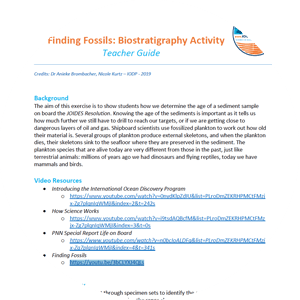Actvity Summary: Students form teams to sort through specimen sets to identify the species of their sample (noted on the group’s range sheet). Using the range sheet, they determine the possible age of their sample set. The individual teams then come together to discuss the results as a whole class. The individual age ranges based on each team are compared to further constrains the age of the sample. Together, all groups determine the final age range of their sample.
The aim of this exercise is to show students how we determine the age of a sediment sample on board the JOIDES Resolution. Knowing the age of the sediments is important as it tells us how much further we still have to drill to reach our targets, or if we are getting close to dangerous layers of oil and gas. Shipboard scientists use fossilized plankton to work out how old their material is. Several groups of plankton produce external skeletons, and when the plankton dies, their skeletons sink to the seafloor where they are preserved in the sediment. The plankton species that are alive today are very different from those in the past, just like terrestrial animals: millions of years ago we had dinosaurs and flying reptiles, today we have mammals and birds.
Video Resources for this activity:
Introducing the International Ocean Discovery Program
PNN Special Report: Life on Board
Developed by Dr. Anieke Brombacher on Expedition 383: Dynamics of Pacific Antarctic Circumpolar Current. Read Anieke’s blog (in Dutch) from the ship here. Can’t read Dutch? You can read the English translations here!
- Standard A: Unifying concepts and processes in science
- Standard B: Science as inquiry
- Patterns
- Scale, proportion, quantity
- Stability and change
- Developing and using models
- Analyzing and interpreting data
- Obtaining, evaluating, and communicating information
- ESS2. D Weather and climate
- LS1.B Growth and development of organisms
